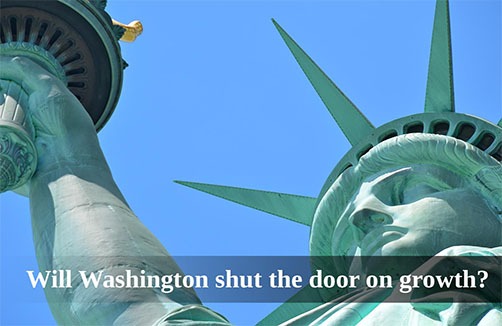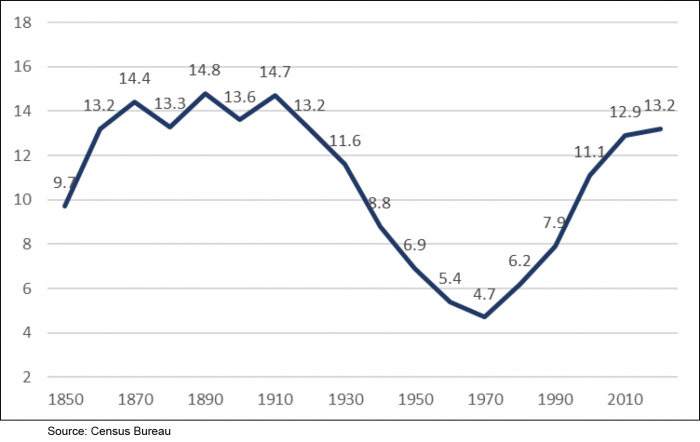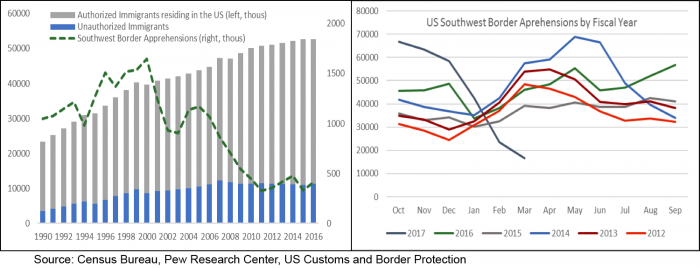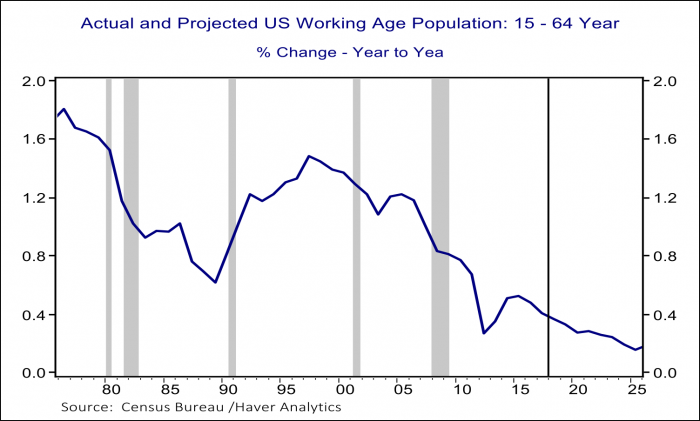
The prospects for immigration policy on the economy
Executive Summary: The Trump Administration is seeking to implement a number of policies that would restrict authorized and unauthorized immigration even as he aspires to guide the economy to a higher rate of growth. Labor force growth is one of the building blocks of an economy’s growth potential; declining US birth rates and an aging workforce are the overriding reason estimates of the economy’s growth potential have declined by more than a percentage point to below 2% in recent years. Immigration has been an important offset to slower population growth. Research also suggests that immigration has a positive and significant impact on productivity, the other linchpin of potential growth and the driver of improvement in living standards. Successful efforts to reduce immigration may provide a short-term boost to wage growth in some sectors, but will likely come at the cost of near term growth and longer term growth potential.
Immigration was a contentious topic in last year’s US presidential election, and one on which the candidates had sharply differing views and policy proposals. Hillary Clinton took a positive view of immigration and proposed comprehensive immigration reform that would offer unauthorized immigrants a path to citizenship. While many moderate Republicans also favor a path to citizenship and generally have a positive view of immigration, President Trump won the election with a platform that took a distinctly negative view, associating immigrants with crime, lack of wage growth and good jobs, and an increased threat from terrorism. He has proposed building a wall along the Mexican border and issued bans to keep immigrants out.
Immigration policy is an area of policy over which the executive branch exercises a great deal of influence and President Trump has been busy on this front issuing executive orders to ban immigrants from a group of Muslim countries, directing government agencies to review and propose reforms to the H1B visa program, ordering the detainment and deportation of illegal immigrants and cutting funding for sanctuary cities that resist federal efforts to deport immigrants. Some of these orders are in the process of implementation while others are facing legal challenges, but the direction of travel is clear, immigration will face increasing restrictions under the Trump Administration.
Many political debates, and much of the existing economic research on immigration centers on whether immigrants displace American workers, reduce wages, and increase demands on government budgets for public services n the cities and regions they arrive in. As a macro economist, I will take a somewhat different angle and examine what effect immigration has on the building blocks of potential growth. The potential growth rate of the economy is the pace at which it can be expected to grow over the long run, smoothing through the ebbs and flows of business cycles. It is a matter of accounting that potential growth is the sum of the growth rates of productivity and the labor force.
Chart 1 – Foreign-Born Population in the US as % of Total (As Accounted for in Official Statistics)
Immigration Has Slowed After a Period of Rapid Growth, and Seems Likely to Slow Further
There are two major groups of immigrants in the US, those that come here through legal means through family or employer sponsorship or through government immigration programs. People without family sponsors often come through temporary work or student visas and then apply for permanent residency and eventually citizenship. The other category is people who come in an unauthorized way without a visa, or those that overstay visas. Statistics on unauthorized immigrants are, by definition, difficult to come by and subject to a wide margin of error. Recent estimates from the Census Bureau and the Pew Research Center indicate that that immigrants currently account for more than 16% of the total population in the US and that the unauthorized population accounts for roughly 20 percent of the total immigrant population.
The US is overwhelmingly a nation of immigrants and their descendants, but the share of the population that was born in another country has waxed and waned over time; Chart 1 shows the share of immigrants in the population captured in the official Census statistics is nearing the level seen around the immigrant boom around the turn of the century. The official statistics no doubt undercount the population of unauthorized immigrants. The chart also shows that the growth in the immigrant share of the population has slowed in the past ten years.
The more gently rising immigrant share in the past ten years reflects two trends; growth in immigration has slowed, but native born population growth has slowed even faster reflecting declining birth rates. Chart 2 highlights that both authorized and unauthorized immigration growth has slowed. The number of people receiving green cards, or permanent legal residency each year has been fairly steady at just over 1mn people per year under the Bush and Obama Administrations. New permanent residents account for the bulk of the roughly 2% annual growth in the official foreign-born population in recent years. Many new permanent residents come from a pipeline of people that came to the US earlier on student and work visas, while others are new arrivals through family solicitations and other programs.
Chart 2 – Authorized and Unauthorized Immigration to the US
President Trump has recently ordered a review of the H1B visa program which grants three-year work authorizations to workers in specialty, high skilled occupations that require at least a bachelor’s degree with an option for a three-year extension. The federal government has been granting a fixed quota of 65,000 each year plus an additional 20,000 for foreign students graduating from US institutions with an advanced degree. Under President Obama spouses of H1B workers were also given the legal ability to work. Data show that between new applicants, students, renewals and spouses the government has approved close to 300,000 H1B work petitions each year for the past five years. While the H1B program receives the most headlines, data from the Department of Homeland Security show that the H1B program accounts for only 15% of people entering and exiting the country each year through temporary work programs. There are programs for agricultural workers, company transfers, and visa programs for the arts, media and religious organizations. Policies aimed at reducing the number of people coming to the US to work will, over time, reduce the pipeline of people applying for permanent residency in the US further reduce growth in the authorized immigrant population.
While somewhat obscured by the scale of legal immigrants in Chart 2, estimates from the Pew Research Center suggest that the population of unauthorized immigrants stopped growing a decade ago. This population has stabilized at just over 11mn after having roughly doubled in each of the prior two decades as job prospects in the US deteriorated and those in Mexico and other countries improved. The population of immigrants in the US at any given moment belies a steady churn of people coming and going on student and work visas, as well as unauthorized workers that come and go with the availability of jobs and personal circumstances. Recently President Trump touted a 40% reduction in border crossings. The data he referred to is shown in the right panel of Chart 2 which plots the number of people apprehended along the southwestern border of the US by month in each of the past five fiscal year and the first three months of 2017. There has indeed been an unseasonably sharp drop in people apprehended at the border after a surge at the end of last year. It certainly seems plausible that stepped up enforcement both at the border and throughout the US has reduced the desire or willingness of people to attempt to enter the US illegally. The dotted green line in the left panel highlights that there is a longstanding trend toward reduced border apprehensions presumably reflecting reduced attempts as opportunities in the construction and other sectors dried up leading up to and following the Great Recession. If a trend toward reduced entries is maintained, and the outflow of unauthorized residents also increases due to deportation and voluntary preemptive departures then we could indeed see a decline in the population of unauthorized residents.
Population Growth=Labor Force Growth=Economic Growth
From a macro perspective, labor force growth is one of the pillars of economic growth. Growing populations need houses, schools, and hospitals, and they produce the workers needed to build the additional capacity to provide the required goods and services. Immigrants to the US tend to be younger on average than the native population, 15% were aged 65 and over in 2016 versus 20% of the native-born population. That also means that the share or immigrants in the workforce is higher than their population share. The labor force participation rate of the foreign-born population captured in the official statistics collected by the Bureau of Labor Statistics is reliably at least 3 percentage points higher than that of the native-born population. Making reasonable assumptions about the participation rate of the unauthorized population I estimate that roughly 21% of the prime aged workforce aged 25-64 was comprised of immigrants last year as compared to their 16% population share.
Chart 3 – Actual and Projected Growth in the Working Age Population: 15-64 Years % Y/Y
Both the Federal Reserve and the Congressional Budget Office project potential GDP growth in the next few decades at 1.9%, down from an estimated pace north of 3% just a decade ago. The key engine of the slowdown is slower labor force growth reflecting declining birth rates, an aging cohort of baby boomers, and a slower pace of immigration. The BLS projects that labor force growth will slow from an average of 1.2% from 1994-2001 to 0.5% from 2014-2024, a touch slower than the average growth rate 0.7% growth rate over the past five years. The projections for labor force growth are based on population projections from the Census Bureau that have been updated in recent years for the 2010 Census. The new population projections feature reduced projections for net immigration based on the slower trends in recent decades. Nonetheless the Census Bureau assumes that the US will welcome 1.2mn immigrants per year in coming years, a little above the pace seen in recent years, which will account for more than half of all population growth in the next two decades. The BLS stresses that immigration is the most uncertain component of its projections, while at the same time it is also the “main engine” of projected labor force growth. Policies that meaningfully dent the recent, slower pace of immigration will have a significant impact on the economy’s speed limit. What seem like fairly subdued estimates of potential growth below 2% could easily prove too rosy given the policy goals of the current Administration.
Immigrants Boost Productivity
Research has also found that immigration boosts potential growth through enhanced productivity. One strand of research finds that the impulse associated with increased population growth from immigration boosts investment and, hence productivity.[1] Another area of research finds that immigrants receive a disproportionate and rising share of advanced degrees in the US and account for a disproportionate share of patents.[2] Translating these effects into aggregate productivity growth is difficult, but the data suggest the effect is positive and statistically significant. Official estimates of potential growth from the CBO and the Federal Reserve already embed a fairly rosy assumption that productivity growth is going to quickly bounce back to a pace close to long-run trends between 1.25% and 1.5% from the dismal pace just north of 0.5% over the past five years. While the impact is likely to be felt gradually over a long period of time, policies that limit immigration and make it harder for students and highly skilled workers to come to the US will likely dampen potential growth prospects by limiting any bounce back in productivity growth. Productivity growth is also the source of improvement in living standards, so weak productivity growth serves to increase economic frustrations from wage stagnation and lack of improvement in economic prospects.
Like international trade, the macroeconomic benefits of immigration are seemingly powerful even if there is evidence of some displacement in local labor markets when immigrants first arrive.[3] The 1990s is a perfect example; it was a decade that witnessed the largest influx of immigrants in this nation’s history, yet it also was a decade of enormous economic prosperity that saw the unemployment rate average 4.2% in its final year. In the current environment, immigration restrictions could come as the US economy is closing in on full employment, and could therefore tighten labor markets further, particularly in certain industries and regions. This could lead to higher wage growth in the near term. However, at the macro level immigration is a positive driver of demand growth, and perhaps an underappreciated linchpin to potential growth prospects in the US. While tax and health care legislation are subject to wide ranging checks and balances, the executive branch can have a meaningful impact on growth prospects in relatively short order through immigration policy. In my next blog, I will look at impacts of immigration on specific industries and regions, with a focus on the tri-state area.
[1] See Givanni Peri, “The Effect of Immigrants on U.S. Employment and Productivity”, Federal Reserve Bank of San Francisco Economic Letter, August 30, 2010
[2] See Stuen, E. T., Mobarak, A. M. and Maskus, K. E. (2012), Skilled Immigration and Innovation: Evidence from Enrolment Fluctuations in US Doctoral Programmes*. The Economic Journal, 122: 1143–1176 and Jennifer Hunt & Marjolaine Gauthier-Loiselle, 2010. “How Much Does Immigration Boost Innovation?,” American Economic Journal: Macroeconomics, American Economic Association, vol. 2(2), pages 31-56, April.
[3] See George Borjas, “The Wage Impact of the Marielitos”, NBER Working Paper 21588 (2015)


